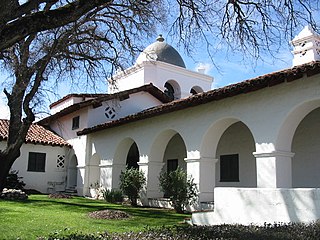
The United States Army Space and Missile Defense Command (SMDC) is an Army Service Component Command (ASCC) of the United States Army. The command was established in 1997.
The current SMDC commander is Lieutenant General James H. Dickinson with Senior Enlisted Advisor Command Sergeant Major Jerome Wiggins.

Air Force Materiel Command (AFMC) is a major command (MAJCOM) of the United States Air Force (USAF). AFMC was created on July 1, 1992, through the amalgamation of the former Air Force Logistics Command (AFLC) and the former Air Force Systems Command (AFSC).

The United States Army Aviation and Missile Command is primarily responsible for life cycle management of army missile, helicopter, unmanned ground vehicle and unmanned aerial vehicle weapon system. The central part of AMCOM's mission involves ensuring readiness through acquisition and sustainment support for aviation systems, missile systems, and test, measurement, and diagnostic equipment (TMDE) throughout their life cycle. The command is headquartered at Redstone Arsenal by Huntsville, Alabama.
Air Materiel Command (AMC) was a United States Army Air Forces and United States Air Force command. Its headquarters was located at Wright-Patterson Air Force Base, Ohio. In 1961, the command was redesignated the Air Force Logistics Command with some of its functions transferred to the new Air Force Systems Command.

Established 1 July 1973, the United States Army Training and Doctrine Command (TRADOC) is a command of the United States Army headquartered at Fort Eustis, Virginia. It is charged with overseeing training of Army forces and the development of operational doctrine. TRADOC operates 37 schools and centers at 27 different locations. TRADOC schools conduct 1,304 courses and 108 language courses. The 1,304 courses include 516,000 seats for 443,231 soldiers; 36,145 other-service personnel; 8,314 international soldiers; and 28,310 civilians.

The Naval Air Systems Command (NAVAIR) provides material support for aircraft and airborne weapon systems for the United States Navy. It is one of the various Navy systems commands, and was established in 1966 as the successor to the Navy's Bureau of Naval Weapons.

The Engineer Research and Development Center (ERDC) is a US Army Corps of Engineers (USACE) laboratory organization whose mission is to "Provide science, technology, and expertise in engineering and environmental sciences in support of our Armed Forces and the Nation to make the world safer and better." The headquarters is located in Vicksburg, Mississippi, on the site of an antecedent organization, the Waterways Experiment Station.

The United States Army Center of Military History (CMH) is a directorate within TRADOC. The Institute of Heraldry remains within the Office of the Administrative Assistant to the Secretary of the Army. The center is responsible for the appropriate use of history and military records throughout the United States Army. Traditionally, this mission has meant recording the official history of the army in both peace and war, while advising the army staff on historical matters. CMH is the flagship organization leading the Army Historical Program.

The Army Research Laboratory (ARL) is the U.S. Army's corporate research laboratory. ARL is headquartered at the Adelphi Laboratory Center (ALC) in Adelphi, Maryland. Its largest single site is at Aberdeen Proving Ground, Maryland. Other major ARL locations include Research Triangle Park, North Carolina, White Sands Missile Range, New Mexico, Orlando, Florida, and NASA's Glenn Research Center, Ohio and Langley Research Center, Virginia.

Fort Hunter Liggett, named after General Hunter Liggett in 1941, is a United States Army fort in southern Monterey County, California, about 250 miles (400 km) north of Los Angeles and 150 miles (240 km) south of San Francisco. The fort is primarily used as a training facility, where activities such as field maneuvers and live fire exercises are performed. It is roughly 25 miles northwest of Camp Roberts, California.

The U.S. Army Combined Arms Center (USACAC) is located at Fort Leavenworth and provides leadership and supervision for leader development and professional military and civilian education; institutional and collective training; functional training; training support; battle command; doctrine; lessons learned and specified areas the Commanding General, United States Army Training and Doctrine Command (TRADOC) designates in order to serve as a catalyst for change and to support developing relevant and ready expeditionary land formations with campaign qualities in support of the joint force commander.
The Centro di Documentazione Ebraica Contemporanea is an independent cultural and historical institution in Milan, Italy, dedicated to promoting the study of the events, culture, and circumstances of the Jewish People in Italy in the context of modern times.
Fernbridge is an unincorporated community at an elevation of 39 feet (12 m) in Humboldt County, California, named for a historic bridge, 3 miles (4.8 km) west-northwest of Fortuna.

The Combat Capabilities Development Command, (CCDC) is a subordinate command of the Combat Development Command, U.S. Army Futures Command. RDECOM was tasked with "creating, integrating, and delivering technology-enabled solutions" to the U.S. Army. Headquartered at Aberdeen Proving Ground in Maryland, RDECOM employed more than 13,000 scientists, engineers, researchers, and support personnel working at six major RDE centers and at the U.S. Army Research Laboratory, providing nearly all of the Army's basic and applied research and development services, including in collaboration with other branches of the armed forces and through a network of more than a thousand academic, industrial, and international partners.

The United States Army Armament Research, Development and Engineering Center (ARDEC), headquartered at the Picatinny Arsenal in New Jersey, is the US Army's primary research and development arm for armament and munitions systems. Besides Picatinny, ARDEC has four other research facilities, including Benét Laboratories. ARDEC works to develop more advanced weapons using technologies such as microwaves, lasers and nanotechnology. In February 2019 ARDEC was designated the Combat Capabilities Development Command Armaments Center upon the establishment of the Army Futures Command.

The United States Army Simulation and Training Technology Center (STTC) provide the United States Department of Defense and United States Department of Homeland Security with state-of-the-art applied research to develop simulation technologies, build on current simulation knowledge, and understand system of systems environments where human, agent, and teams are involved.
The Soldier Support Institute (SSI) at Fort Jackson, South Carolina is a U.S. Army organization and major subordinate command of the Combined Arms Support Command and part of the Sustainment Center of Excellence (SCoE). It is also part of the Training and Doctrine Command (TRADOC).

The Naval Sea Systems Command (NAVSEA) is the largest of the United States Navy's five "systems commands," or materiel organizations. NAVSEA consists of four shipyards, ten "warfare centers", four major shipbuilding locations and the NAVSEA headquarters, located at the Washington Navy Yard, in Washington D.C.
Thomas H. Morrin was an engineer and the director of engineering at SRI International from 1948 to 1963.

The U.S. Army Acquisition Support Center (USAASC) is part of the Office of the Assistant Secretary of the Army for Acquisition, Logistics, and Technology. USAASC is headquartered at Fort Belvoir, Va.

















